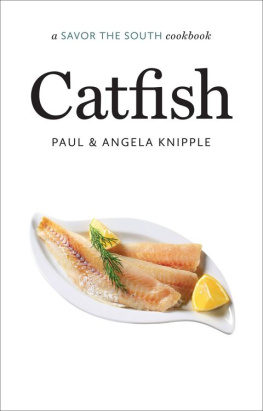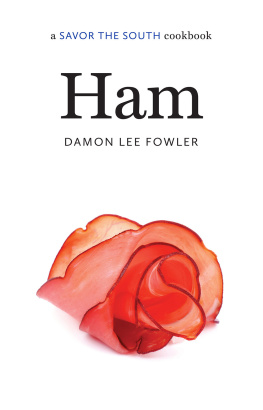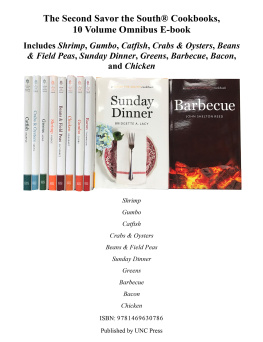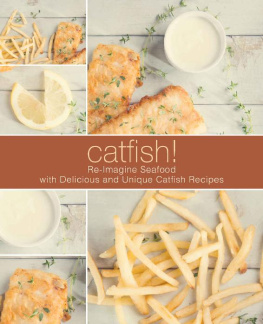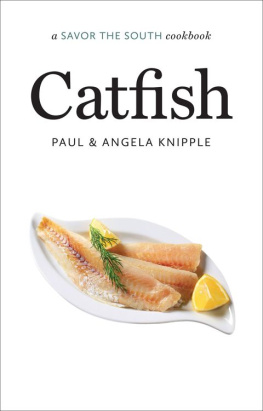Angela Knipple - Catfish: A Savor the South Cookbook
Here you can read online Angela Knipple - Catfish: A Savor the South Cookbook full text of the book (entire story) in english for free. Download pdf and epub, get meaning, cover and reviews about this ebook. year: 2015, publisher: The University of North Carolina Press, genre: Home and family. Description of the work, (preface) as well as reviews are available. Best literature library LitArk.com created for fans of good reading and offers a wide selection of genres:
Romance novel
Science fiction
Adventure
Detective
Science
History
Home and family
Prose
Art
Politics
Computer
Non-fiction
Religion
Business
Children
Humor
Choose a favorite category and find really read worthwhile books. Enjoy immersion in the world of imagination, feel the emotions of the characters or learn something new for yourself, make an fascinating discovery.
- Book:Catfish: A Savor the South Cookbook
- Author:
- Publisher:The University of North Carolina Press
- Genre:
- Year:2015
- Rating:5 / 5
- Favourites:Add to favourites
- Your mark:
- 100
- 1
- 2
- 3
- 4
- 5
Catfish: A Savor the South Cookbook: summary, description and annotation
We offer to read an annotation, description, summary or preface (depends on what the author of the book "Catfish: A Savor the South Cookbook" wrote himself). If you haven't found the necessary information about the book — write in the comments, we will try to find it.
Catfish: A Savor the South Cookbook — read online for free the complete book (whole text) full work
Below is the text of the book, divided by pages. System saving the place of the last page read, allows you to conveniently read the book "Catfish: A Savor the South Cookbook" online for free, without having to search again every time where you left off. Put a bookmark, and you can go to the page where you finished reading at any time.
Font size:
Interval:
Bookmark:
a SAVOR THE SOUTH cookbook
SAVOR THE SOUTH cookbooks
Catfish, by Paul and Angela Knipple (2015)
Shrimp, by Jay Pierce (2015)
Gumbo, by Dale Curry (2015)
Sweet Potatoes, by April McGreger (2014)
Southern Holidays, by Debbie Moose (2014)
Okra, by Virginia Willis (2014)
Pickles and Preserves, by Andrea Weigl (2014)
Bourbon, by Kathleen Purvis (2013)
Biscuits, by Belinda Ellis (2013)
Tomatoes, by Miriam Rubin (2013)
Peaches, by Kelly Alexander (2013)
Pecans, by Kathleen Purvis (2012)
Buttermilk, by Debbie Moose (2012)
a SAVOR THE SOUTH cookbook
Paul and Angela Knipple
The University of North Carolina Press
Chapel Hill
2015 Paul and Angela Knipple
All rights reserved. Manufactured in the United States of America.
SAVOR THE SOUTH is a registered trademark of the
University of North Carolina Press, Inc.
Designed by Kimberly Bryant and set in Miller and
Calluna Sans types by Rebecca Evans.
The paper in this book meets the guidelines for permanence and durability of the Committee on Production Guidelines for Book Longevity of the Council on Library Resources. The University of North Carolina Press has been a member of the Green Press Initiative since 2003.
Jacket illustration: depositphotos.com/ajafoto
Library of Congress Cataloging-in-Publication Data
Knipple, Paul.
Catfish / by Paul and Angela Knipple.
pages cm. (Savor the south cookbooks)
Includes index.
ISBN 978-1-4696-2130-2 (cloth: alk. paper)
ISBN 978-1-4696-2131-9 (ebook)
1. Cooking (Catfish) 2. Cooking, AmericanSouthern style.
I. Knipple, Angela. II. Title.
TX748.C36K56 2015 641.692dc23
2014024702
19 18 17 16 15 5 4 3 2 1
We dedicate this book to fidgety grandchildren and patient grandparents, to cane poles and bait of all sorts.
No matter what you catch, you have set a hook firmly in good memories.
a SAVOR THE SOUTHcookbook
Zen and the art of Catfishing
For southerners, catfish is about more than the meal. Theres also the hunt. Giant catfish were always the topic of stories about the one that got away.
We were no different. When we were growing up in and around Memphis, our fishing trips were adventures that only children can have and, perhaps, that can be experienced only with grandparents leading the way.
Angelas catfish history begins with an almost-forgotten southern creationrag bologna. You may have seen it behind small-town deli counters or hiding in the lunchmeat section. It was labeled imitation bologna, which begs the question, Really? Imitation bologna? Isnt bologna one of those things you like to eat but try not to think about whats in it, kind of like hot dogs?
Well, it turns out that rag bologna is a cousin of the slugburger. What in the world is a slugburger, and isnt this book supposed to be about catfish? Back during the Great Depression, when our grandparents were growing up, people used fillers like soy meal, bread crumbs, or flour to stretch ground meat. In North Mississippi, the slugburger, a combination of beef and soy meal, was born. Another more common meat containing a filler throughout the region was rag bologna, slightly sweeter and less spicy than the real thing and wrapped in, you guessed it, rags.
Heres where catfish come into the story. Angelas grandfather swore by rag bologna as catfish bait. His fishing ritual began with breakfast at the country store, where he and his friends from decades back would share stories and swap news. Thats also where he and Angela bought their rag bologna bait, packed up lunch, and got a couple of icy cold sodas and Angela got to pick a toy off the less-than-a-dollar rack. Plastic dinosaurs were a favorite, but army men would do in a pinch. Then it was off to the lake.
To call this a lake is an exaggeration. Its a big pond that anchored the community where they lived. Angela was taught that fishing meant tying a hook on a cane pole, baiting it with rag bologna, throwing the line in the water, setting the pole in the bank, and waiting. You had to be still, or the fish would see your shadow move and stay away. You had to be quiet, or theyd hear you and go deep. You couldnt expect them to bite right away; catfish have to have time to inspect the bait and decide whether they want it. If you didnt catch any that day, it wasnt a failure; it just wasnt meant to be. You would still look upon it as a day well spent. Zen and the art of catfishing.
They usually caught some fish, but the ritual of the day and the time spent together were most important. There were, however, rules. If you caught a fish, you had to decide its fate immediatelyfree it or clean it. Angela learned to clean fish early and remembers being squeamish about eating the first fish she cleaned, but thats part of the experience too.
Pauls story is similar. When he was around six, his grandmother took him to visit her brother. When they arrived, Uncle Lee was just about to go out onto the pond behind his house to check his trotlines.
A trotline is a line tied between two trees, poles, or other stationary objects over a body of water. Other lines are tied to it, hooked, baited, and left to dangle in the water. The idea is that, rather than spending the day waiting on the bank, the fisherman can set the lines, go about his business, and then return later to trot along the bank retrieving the catch. This is a results-oriented system, not a relax-on-the-bank-with-a-pole system.
Being too small to go out on the boat, Paul was left to watch, sorely disappointed, from the bank as Uncle Lee and his own grandson hauled in a forty-seven-pound monster. Among Pauls family mementos is a picture of him and his cousin with Uncle Lee, who is holding a fish that Paul remembers, not entirely incorrectly, being nearly as long as he was tall.
For Pauls family, one fished for more than just the thrill. Another of Pauls distinct catfish memories involves his grandmothers brother-in-law, Uncle Henry, who was at the center of one of Pauls earliest food memories, a memory thats integral to Pauls connection to food.
On one visit, Uncle Henry had just returned from fishing at one of his two ponds, and Paul got his first lesson in putting meat on the table by dispatching a living creature and preparing it for consumption. Paul cleans catfish today using the very same methods. This experience impressed on Paul not only the fragility of life but also the importance of the tools in Uncle Henrys tackle box. This wasnt a spectacle for Pauls benefit. It was life and deatha way of life and life itself.
This is not to say that a day with catfish turned a young boy into a philosopher and a young girl into a Zen master. It simply shows how our personal food histories began with catfish.
The steamy sweet white meat of catfish encased in golden crisp cornmeal was a part of childhood for both of us. It was there at church suppers and fundraisers, at family reunions and family suppers.
For Angela, catfish is the taste of coming home. Theres a catfish restaurant near the Memphis airport called Catfish Cabin. She used to travel a great deal for work, and after returning to the Memphis airport, it was always her first stop for a massive glass of sweet tea and a plate of crispy fish. For Paul, its one of the first restaurants he can remember going to, digging into a plate of fish with perfect hushpuppies filled with crisp corn kernels and a touch of heat from jalapeos. We dont hesitate to take anyone there when we pick them up at the airport. Its a catfish indoctrination.
Font size:
Interval:
Bookmark:
Similar books «Catfish: A Savor the South Cookbook»
Look at similar books to Catfish: A Savor the South Cookbook. We have selected literature similar in name and meaning in the hope of providing readers with more options to find new, interesting, not yet read works.
Discussion, reviews of the book Catfish: A Savor the South Cookbook and just readers' own opinions. Leave your comments, write what you think about the work, its meaning or the main characters. Specify what exactly you liked and what you didn't like, and why you think so.

